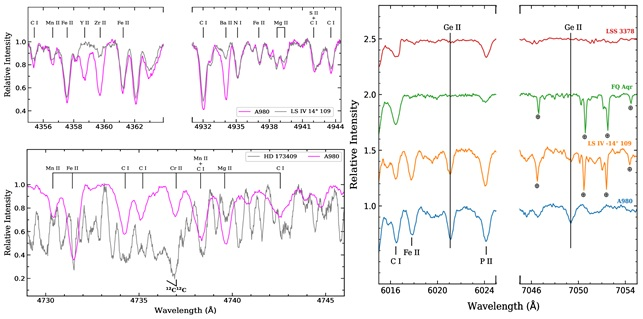Indian Scientists Uncover Germanium-Rich Helium Star, Redefining Stellar Chemistry
EHe stars are an exceptionally rare class of evolved stars that contain almost no hydrogen, the most abundant element in the universe, and are composed almost entirely of helium.

- Country:
- India
In a groundbreaking astronomical discovery, researchers from the Indian Institute of Astrophysics (IIA) have identified singly-ionized germanium (Ge II) in a rare type of star known as an Extreme Helium (EHe) star, marking the first-ever detection of germanium in such a celestial body. This extraordinary find centers around A980, a peculiar star nestled in the Ophiuchus constellation, some 25,800 light-years away from Earth.
A Rare Class of Stars: Understanding Extreme Helium Stars
EHe stars are an exceptionally rare class of evolved stars that contain almost no hydrogen, the most abundant element in the universe, and are composed almost entirely of helium. Only a handful of such stars have been identified so far, making any new observation of this type highly significant. These stars are thought to arise from the merger of two white dwarfs—one rich in carbon and oxygen, and the other rich in helium—triggering a cosmic alchemy that redefines stellar structure.
A980 was initially misclassified as a hydrogen-deficient carbon (HdC) star due to its unusual spectral characteristics. But closer examination revealed it to be a cool EHe, based on spectral similarities with the known EHe star LS IV -14° 109.
Unveiling the Chemical Enigma with Himalayan Chandra Telescope
Using the state-of-the-art Hanle Echelle Spectrograph mounted on the 2-metre Himalayan Chandra Telescope in Ladakh, astronomers led by Ajay Saini, under the supervision of Dr. Gajendra Pandey, uncovered spectral lines that had never been seen before in an EHe star.
In particular, singly-ionized germanium (Ge II) lines at wavelengths λ6021.04 and λ7049.37 Å stood out in the star’s optical spectrum, confirming the presence of germanium in an environment where its existence had never previously been recorded.
“These are the first-ever detections of germanium lines in an EHe’s observed spectrum and provide the first measurements of germanium abundance in an EHe star,” explained Dr. Pandey.
Germanium Eight Times More Abundant Than in the Sun
Quantitative spectral analysis revealed that germanium in A980 is nearly eight times more abundant than it is in the Sun. This enrichment is a profound indication that nucleosynthesis—the formation of heavier elements—occurred within the star, likely through the slow neutron-capture process, or s-process. This mechanism is known to create elements heavier than iron and typically occurs during the Asymptotic Giant Branch (AGB) phase of stellar evolution.
Additionally, A980 displayed enhanced abundances of s-process elements, making it stand out even among other EHe stars.
A Tale of Stellar Mergers and Nucleosynthesis
The study supports the prevailing theory that cool EHe stars originate from the merger of a carbon-oxygen white dwarf and a helium white dwarf. During this cataclysmic fusion, the resultant star may undergo internal mixing and nuclear reactions that give rise to unusual chemical compositions.
However, another theory looms intriguingly in the background. The A980's unusual abundance patterns bear some resemblance to Thorne-Żytkow Objects (TŻOs)—exotic, theoretical stars that consist of a neutron star core surrounded by a red supergiant envelope. TŻOs are predicted to produce germanium and other heavy elements through the rapid proton capture process (rp-process), although A980 doesn’t fully conform to the profile of a typical TŻO.
This leaves open the tantalizing question—could A980 represent a new or transitional class of stellar objects?
Visualizing the Spectral Evidence
Spectral comparisons with other known EHe and HdC stars—specifically LS IV -14° 109, FQ Aqr, LSS 3378, and HD 173409—were key to identifying the unique features in A980. In particular, the presence and strength of Ge II lines helped distinguish it from other cool EHes and cemented its position as a new chemical outlier.
Figures from the study display comparative spectra where A980's Ge II lines are highlighted alongside those of other rare stars, offering visual confirmation of its distinctive chemical fingerprint.
Pioneering Contributions from Indian Astronomy
This discovery not only enriches the study of stellar chemistry but also showcases India’s growing capabilities in high-resolution spectroscopy and observational astrophysics. The work, recently published in The Astrophysical Journal, signifies a landmark moment for the IIA and India’s broader astronomical community.
“This discovery pushes the boundaries of what we thought we knew about stellar chemistry,” said Dr. Pandey. “It also shows how powerful high-resolution spectroscopy can be in uncovering the hidden stories written in starlight.”
Implications for Stellar Evolution and Galactic Chemistry
The identification of germanium in an EHe star provides a new puzzle piece in the cosmic jigsaw of element formation. It opens new avenues for research into the late stages of stellar evolution, particularly in binary systems and white dwarf mergers. By illuminating such rare chemical pathways, A980 offers a glimpse into the dynamic and complex processes that govern the life and death of stars.
As scientists continue to probe the universe for stars like A980, one thing is clear: every rare star tells a story—not just about itself, but about the galaxy’s past, and the universe’s elemental heritage.










